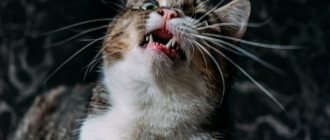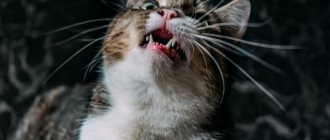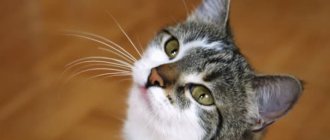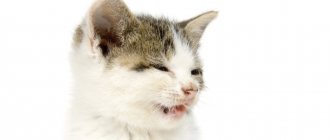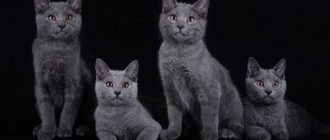12439Administration
1
Cats, like people, get sick often. Coughing and sneezing is not uncommon for them, but a serious symptom! If a cat is sneezing and coughing, this is a sign of illness that the owner needs to be aware of. The mechanism of coughing and sneezing may indicate different reasons for its occurrence - discomfort, colds, illness, allergies, and so on. To quickly help and try to cure a pet is the main task of the owner who cares and loves his pet friend!
A cat is sneezing and coughing - what does this mean?
Sneezing and coughing are a reflex defense of the animal’s body, aimed at eliminating the irritating element. The sneezing response is controlled by the cough center located in the cat's medulla oblongata. Sneezing in a cat is caused by special receptors concentrated on the larynx , trachea, vocal cords and bronchi. The cat sneezes and coughs due to mechanical or chemical irritation of sensitive cough areas. Treatment of a cough symptom is based on the external and internal causes that led to its occurrence. In some cases, you may need the help of a doctor.
To find out the causes of sneezing in cats, you need to pay attention to the following signs and features. This is the time of appearance and end, the strength of manifestation, the duration and timbre of the cough. Of no less importance are the accompanying symptoms, the behavior of the cat, and the nature of the discharge, if any.
© shutterstock
Depending on the signs, veterinarians divide coughing and sneezing in cats into several types:
- Wet and dry, if there is no or no discharge.
- Distressing and debilitating, depending on the severity of the symptom.
- Paroxysmal and chronic, based on duration and frequency.
- Voiced and voiceless, as evidenced by the nature of the sound manifestation of this feature.
Often sneezing indicates problems with the respiratory or cardiovascular systems.
It is possible to clarify the diagnosis of an animal when sneezing only after conducting certain studies and passing the necessary tests.
Why does a cat cough and sneeze? Let’s look at the main reasons
The reasons that a cat sneezes are no less than the reasons for coughing. Treatment also depends on the cause of the disease. So, if it is a fungus, then drugs are used against it. If a foreign body is stuck in the nose or trachea, the doctor must remove it. And so on for each disease.
Here we will look at the main causes and methods of treating them, however, the information is for informational purposes only and it is strictly not recommended to treat your pet on your own.
Upper respiratory tract infections in cats
It is upper respiratory tract infections in cats that become the most common cause of sneezing in cats. There are different types of infections: fungus, bacteria and viruses. The symptoms are approximately the same:
- Kitten sneezes
- Coughs often
- His nose is wet
- Eyes with tears
Allergies in cats
As already mentioned, cats suffer from allergies no less than people. The reasons are the same as for people: dust, strong smoke from cigarettes or hookahs, pollen and flowering, various powders, new tray fillers, the smell of food, air fresheners, etc. In such cases, the cat rubs its nose on the surface, as well as with its paws. A cat sneezes only when it is in an allergenic environment; its nose also becomes wet and a runny nose appears. The pet wants to quickly run away from the place where the attacks began.
If you are allergic only to the litter for the tray, then you just need to change it and the allergy will go away, you don’t need to do anything else. If some allergen gets stuck in the pathways and causes discomfort for a long time, you need to consult a doctor for help. It is also worth noting that the exacerbation begins during flowering periods in the spring and sometimes in the fall, so it is enough just to survive short periods of time and suffer a sneeze, but then it will all end and the cat will feel good.
Asthma in cats
Cats also have asthma. A few words have already been said about it, but in some cases the pet coughs, and in others it sneezes. They are treated approximately the same. The cause of the disease is a long interaction with the allergen, which caused sneezing and now continues to do so on a constant and almost chronic basis. They are often treated with warm steam, which the pet inhales. This helps clear the bronchi of excess.
Heartworms in cats
As you know, mosquitoes are carriers of bacteria and diseases; just remember malaria in Africa. However, not everyone knows that mosquitoes can infect a cat with a simple bite. Microscopic larvae enter the body through the insect's proboscis. Through blood vessels and pathways they enter the heart, or more precisely, into its right chambers. The nearby pulmonary and cardiac arteries are affected, the worms become clogged and make breathing difficult, causing the pet to sneeze. If he sneezes frequently, the arteries become clogged and sometimes a heart attack occurs. The main symptoms here are the cat's sneezing and coughing.
Only a veterinarian who has already encountered a similar problem should treat a pet in such a situation. You can’t ignore it and you also can’t advise anything, because the case is serious and requires equally serious intervention from a specialist. It is better, of course, to carry out preventive procedures to avoid infection in principle.
Dental problems in cats
Sometimes it happens. Yes, this is rare, but if there are any problems with the teeth (smell from the mouth, suppuration, gum disease). The infection that struck and caused these causes also reaches the respiratory tract, which leads to sneezing. This happens to kittens that are still weak and their immunity is susceptible to attack.
Causes of cat cough and sneezing
The cause of a cat’s cough can be caused by the banal entry of a foreign body into the animal’s nose and respiratory tract - hairballs, food, dust, smoke, liquid, small household items, and so on. By coughing and sneezing, the pet protects its body from possible harm . Also in the cough process there is a natural elimination of inflammatory products and irritants.
Diseases associated with cough and sneezing symptoms:
- Asthma. This disease is very common among the cat breed. The cough is paroxysmal, accompanied by sneezing, shortness of breath, wheezing and difficulty breathing of the animal. The development of the disease is facilitated by poor nutrition, stress, physical activity, polluted environment, and so on. Asthma in cats worsens in the spring and autumn.
- Pneumonia manifests itself along with a dry, exhausting cough, fever, lack of appetite and general depression in the pet. The development of the disease occurs rapidly, most often against the background of hypothermia.
- Cardiovascular failure. Cats may have what is called "cardiac cough," when the heart valve weakens and the heart muscle swells and begins to compress the trachea. Here the cough pattern tends to increase as the pet's condition worsens.
- Allergic reaction. The cat often sneezes due to allergies. Irritating allergens can include tobacco smoke, chemicals and perfumes, mold and spores, dust and pollen.
- Respiratory diseases. Cats sneeze intensely if they have a cold. A cold occurs due to prolonged exposure to the street in bad weather and hypothermia of the animal's body. In parallel with sneezing, the cat becomes lethargic and apathetic, eats little and sleeps a lot, and may develop a fever. The animal's eyes begin to water, and a runny nose often occurs.
- Viral diseases. These include the herpes virus, rhinotracheitis and calicivirus, which affect the mucous membranes of the eyes and nasopharynx. Additional symptoms here are fever, drooling, runny nose and conjunctivitis. It is useless to treat the animal yourself; you should show your pet to a doctor.
- Worms can cause coughing and sneezing in a cat, as the animal reflexively tries to free itself from them. The cat sneezes and coughs up vomit, helminthic larvae and worms, while the animal presses itself to the floor and stretches its neck. The nature of these symptoms is moderate and short-lived.
Microtraumas of the throat and larynx can also cause cough symptoms. Fish and poultry with bones can injure the trachea and esophagus , resulting in tickling and vomiting; sometimes blood can be found in the saliva. Cough symptoms will disappear as wounds and scratches on the animal’s mucous membrane heal.
© shutterstock
Causes
The causes of cough in a cat can be very different, and the most common of them are:
- allergy;
- respiratory tract disease;
- respiratory infection;
- cardiovascular diseases;
- helminthiasis;
- entry of a foreign object into the respiratory tract;
- oncology in the breast organs.
The problem may be associated with mycoplasmosis, rhinotracheitis or other respiratory tract infections, as well as worms, especially if the cat coughs with his tongue hanging out.
Experts name up to a hundred reasons why a domestic cat may start sneezing and coughing. Therefore, you should not start treatment on your own or give your pet any medications, especially those intended for people. All this can make it difficult to make a diagnosis in a veterinary clinic. It is worth remembering that improper use of medications can seriously aggravate the disease.
In a situation where a cat is sick, the owner is required to observe the pet’s behavior and remember all the symptoms in order to accurately describe them to the veterinarian:
- type of cough: wet, dry;
- frequency of appearance by time of day: night, day, morning, evening;
- duration: chronic, acute;
- character: paroxysmal, constant, shortness of breath, heavy breathing;
- effort: slight cough, hysterical, wheezing;
- sound features: dull cough, ringing.
Diagnosis of the disease
Sneezing and coughing, as symptoms, do not come one at a time; the disease is always accompanied by a complex symptom complex, which an experienced and knowledgeable veterinarian can recognize. To alleviate the pet’s condition, it is necessary to humidify and refresh the air in the room, provide warmth and peace to the animal.
Cough requires treatment with special medications, which should be prescribed by a doctor, based on the clinical picture and diagnosis.
What happens in a veterinary clinic when examining an animal:
- The doctor asks questions about the living conditions and characteristics of the cat.
- The owner must be given full information about why and when the cough occurred, and what was done.
- The animal will undergo a general examination, the doctor will examine in detail the upper parts of the respiratory system.
- In some cases, it may be necessary to take x-rays and take blood tests from the animal.
- If a specific disease is suspected, a specific organ of the pet is examined separately.
- In some cases, it is recommended to take a culture test for microflora and viral infections.
Diagnosis of coughing and sneezing takes a lot of time, but only in this case will the diagnosis and treatment be correct and effective.
Cat sneezing: causes and treatment at home
It's funny when a cat sneezes, but a runny nose in cats is most often the cause of a cold, which is not dangerous for the animal if treated. But, unfortunately, in domestic cats, nasal discharge can indicate allergies and serious diseases. The correct diagnosis will be made by a veterinarian. Our article is about the causes of a runny nose, what to do if a cat sneezes , types of nasal diseases accompanied by a runny nose, and how to treat an animal at home.
Sinusitis in cats
Sinusitis is difficult to diagnose on your own. Colds in cats have similar symptoms. In cats, the symptoms of sinusitis do not differ from those in humans - the cat rubs its nose with its paw, tries not to make sudden movements of its head, becomes less mobile, sneezes often, body temperature is slightly elevated, nasal discharge is cloudy, sometimes greenish in color, and stretchy.
Treatment at home
1. For instillation: Maxidin (0.15%) or Furacilin (0.1%).
2. Treat the nose with chlorhexedine.
3. Lubricate the nostrils with oxolinic ointment
.
4. Drip 1 drop of St. John's wort decoction into the nostrils - the herb stops the growth of pathogenic microflora.
5. Penicillin antibiotics are needed.
6. If possible, provide the animal with warming up.
